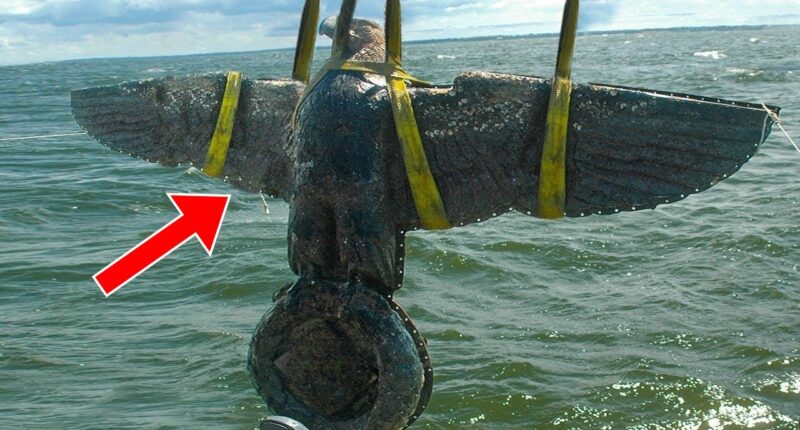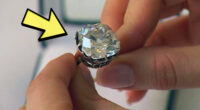Dr. Alexander’s breath was slow and steady, yet his heart pounded like a war drum against his wetsuit. The ocean’s surface shimmered under the moonlight as he hovered over the wreckage below, gripping his flashlight with white-knuckled intensity. His instincts told him this was no ordinary dive. Something down there called to him—a whisper from history, luring him into the abyss.
Descending through the eerie silence of the deep, he navigated past jagged remnants of what once was a mighty vessel. The ship had surrendered to time, its wooden ribs rotting and its metallic bones twisted beyond recognition. Yet, even as it lay entombed beneath layers of silt, there was something unnatural about the way it remained intact, as if the ocean itself feared disturbing it.
Then he saw it.
Amidst the decayed wreckage, partially buried beneath centuries of sediment, lay a shape too distinct, too refined, to be part of the ship. Dr. Alexander swept away layers of debris with gloved hands, revealing an enormous stone wing. The intricate carvings, still visible despite years under the crushing weight of the sea, depicted the fierce and commanding gaze of an eagle—a Roman eagle.
His breath hitched. A Roman artifact? Here? The implications sent a shiver through his spine. If genuine, this discovery could shatter everything historians believed about the reach of the Roman Empire.
A Discovery That Defies History
Rising back to the surface, Dr. Alexander’s mind raced. The ocean air felt heavier, the night darker. He knew what he had found could be world-changing.
The artifact bore a clear insignia at its base—a symbol unmistakably Roman. But how could that be? Official records placed the furthest reaches of Roman influence thousands of miles away. No accounts, no ancient maps, no evidence had ever suggested Roman presence in these waters.
Gripping his radio, he made the call. Within hours, the Coast Guard arrived, their skepticism quickly turning to astonishment as they gazed upon the massive relic. This was no hoax. Together, they secured the statue with thick cables, and a crane groaned under the weight as it hoisted the eagle from the ocean’s depths.
The news spread like wildfire. Soon, journalists, archaeologists, and historians from across the globe descended upon the site, hungry for answers. Was this proof of an undocumented Roman expedition?
Dr. Alexander found himself at the center of a media frenzy. Some hailed him as a revolutionary archaeologist; others accused him of fabricating the discovery. Experts debated, scholars argued, and conspiracy theorists spun wild tales of lost Roman colonies and secret imperial voyages.
Yet amidst the chaos, one question lingered in Dr. Alexander’s mind. Had he uncovered something that was meant to remain hidden?
The Uneasy Presence of the Eagle
Days passed, and the statue was carefully transported to a secure research facility. As marine archaeologists worked tirelessly to remove centuries of accumulated sediment, hidden details emerged—fine inscriptions, delicate engravings, and most astonishingly, a sculptor’s signature.
The name matched that of a renowned Roman artist, a craftsman whose works were reserved exclusively for the imperial court. This revelation turned the discovery from significant to monumental. If the Roman elite had commissioned this piece, how had it ended up here, thousands of miles away from its known domain?
Yet, despite the excitement, Dr. Alexander couldn’t shake a feeling of unease. The statue carried an energy—something unexplainable.
That night, as he worked alone in the lab, he noticed a strange glow reflecting off the eagle’s wings. He blinked, shaking off the illusion. But the air had changed—it was colder.
Then came the sound.
A deep, echoing clang from the far side of the lab.
Dr. Alexander spun around, pulse racing. He was alone. Wasn’t he?
Another clang. Closer this time.
His grip tightened around his clipboard. The rational part of his mind told him it was just the building settling. The other part, the part drowning in exhaustion and adrenaline, whispered a more chilling thought: What if something had followed the statue from the depths?
A Scroll That Changes Everything
The eerie encounters continued, but soon, the scientific breakthroughs outpaced the fear. Researchers uncovered a hollow cavity within the eagle’s base. Inside, protected from centuries of decay, lay a metal cylinder, sealed tight.
With bated breath, they opened it.
Inside, wrapped in waterlogged but still decipherable parchment, was a scroll written in Latin.
Its contents sent a shockwave through the team. The words spoke of an imperial directive, a voyage sent in secret, an order to explore distant, uncharted waters. More chillingly, it carried a final, cryptic warning:
“Under no circumstances shall you return. The eagle remains. The curse follows.”
Dr. Alexander’s hands trembled as he translated the words.
The implications were staggering. This wasn’t just an artifact. This was a buried secret, a suppressed chapter of history.
But why had the Romans abandoned their mission? What had they encountered that forced them to leave without returning?
The Growing Frenzy and the Hidden Coordinates
With each new revelation, the world’s attention intensified. Some claimed the eagle was proof of early Roman contact with civilizations previously unknown. Others feared the implications of the cryptic warning.
Then, another bombshell dropped.
Hidden beneath layers of corrosion inside the statue’s base were coordinates—numbers that, when mapped, aligned suspiciously with modern charts.
They indicated a precise location far from the wreck site.
This was no accident. Someone—somewhere—wanted the statue to be found.
Yet, one final detail unsettled Dr. Alexander the most. Among the Roman markings, another symbol had surfaced—one not Roman, not Latin. An unfamiliar emblem, possibly from another culture entirely.
Was this proof that the Romans had made contact with an unknown civilization? Or worse—that they had encountered something beyond their understanding?
The Final Revelation
As government officials swarmed the research site, the artifact was declared a protected historical treasure. Dr. Alexander prepared for yet another round of grueling interviews, but his mind was elsewhere.
A new discovery had been made.
The scroll contained a secondary message, written hastily, as if the author had been in a panic.
“We should never have come. The stars whispered warnings, and the sea grew restless. The eagle remains, but it watches. It waits. Do not return.”
Dr. Alexander swallowed hard. His scientific mind urged him to dismiss the words as superstition. But deep down, he knew—the Romans had fled for a reason.
And as he gazed at the eagle, now standing proud under the lab’s fluorescent lights, he couldn’t shake the feeling that it was watching him back.
The storm outside raged. Thunder rattled the windows.
And in the dim glow of the lab, the eagle’s eyes seemed to gleam with a silent, knowing warning.
Had they opened a door that should have remained closed?
Final Thoughts
Dr. Alexander’s discovery was more than an archaeological find—it was a challenge to history itself. The implications were staggering:
Did the Romans reach this distant land centuries before historians believed?
What had they encountered that forced them to leave so abruptly?
And most disturbingly—was the eagle truly just a statue, or something more?
With new investigations underway, one thing is certain:
This is only the beginning.
And somewhere, in the depths of history’s forgotten waters, more secrets await.







